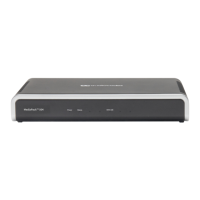Version 6.2 475 February 2011
SIP User's Manual 10. Configuration Parameters Reference
Parameter Description
TrunkGroupSettings_MWIInterrogationType;
[\TrunkGroupSettings]
For example:
TrunkGroupSettings 0 = 1, 0, 5, branch-hq, user, 1, 255;
TrunkGroupSettings 1 = 2, 1, 0, localname, user1, 2, 255;
Notes:
This parameter can include up to 24 indices.
The parameter MWIInterrogationType is not applicable.
For configuring Hunt Group Settings using the Web interface,
see ''Configuring Hunt Group Settings'' on page 126.
For a description on using ini file table parameters, see to
''Configuring ini File Table Parameters'' on page 194.
Web: Channel Select Mode
EMS: Channel Selection Mode
[ChannelSelectMode]
Method for allocating incoming IP-to-Tel calls to a channel (port).
[0] By Dest Phone Number = Selects the device's channel
according to the called number (default.)
[1] Cyclic Ascending = Selects the next available channel in
an ascending cyclic order. Always selects the next higher
channel number in the Hunt Group. When the device reaches
the highest channel number in the Hunt Group, it selects the
lowest channel number in the Hunt Group and then starts
ascending again.
[2] Ascending = Selects the lowest available channel. It
always starts at the lowest channel number in the Hunt
Group and if that channel is unavailable, selects the next
higher channel.
[3] Cyclic Descending = Selects the next available channel in
descending cyclic order. It always selects the next lower
channel number in the Hunt Group. When the device reaches
the lowest channel number in the Hunt Group, it selects the
highest channel number in the Hunt Group and then starts
descending again.
[4] Descending = Selects the highest available channel. It
always starts at the highest channel number in the Hunt
Group and if that channel is unavailable, selects the next
lower channel.
[5] Dest Number + Cyclic Ascending = The device first
selects the channel according to the called number. If the
called number isn't found, it then selects the next available
channel in ascending cyclic order. Note that if the called
number is found but the port associated with this number is
busy, the call is released.
[6] By Source Phone Number = The device selects the
channel according to the calling number.
[9] Ring to Hunt Group = The device allocates IP-to-Tel calls
to all the FXS ports (channels) pertaining to a specific Hunt
Group. When an IP-to-Tel call is received by the device for a
specific Hunt Group, all telephones connected to the FXS
ports belonging to the Hunt Group start ringing. The call is
eventually received by whichever telephone answers the call
first (and the other phones then stop ringing). This option is
applicable only to FXS interfaces.

